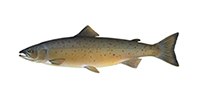Thank you for visiting the Seafood Selector. EDF is planning a new approach to providing information to consumers about good seafood choices. Please come back soon for updates.
Salmon

Salmon
Recommended servings per month
| Contaminant | Men | Women | Kids 6-12 | Kids 0-5 | |
|---|---|---|---|---|---|
| Wild Alaskan salmon (all species) | Mercury | 4+ | 4+ | 4+ | 4+ |
| Farmed or Atlantic salmon (indoor recirculating tanks) | Mercury | 4+ | 4+ | 4+ | 4+ |
| Wild salmon | Mercury | 4+ | 4+ | 4+ | 4+ |
| Salmon (canned) | Mercury | 4+ | 4+ | 4+ | 4+ |
| Chinook salmon (wild, US Pacific) | Mercury | 4+ | 4+ | 4+ | 4+ |
| Chum salmon (Wild, US Pacific) | Mercury | 4+ | 4+ | 4+ | 4+ |
| Coho salmon (wild, US and Canada Pacific) | Mercury | 4+ | 4+ | 4+ | 4+ |
| Pink salmon (Washington) | Mercury | 4+ | 4+ | 4+ | 4+ |
| Sockeye salmon (Washington, Oregon) | Mercury | 4+ | 4+ | 4+ | 4+ |
| Farmed or Atlantic salmon (conventional net pens) | 4+ | 4+ | 4+ | 4+ | |
| Farmed or Atlantic salmon (British Columbia, Faroe Islands, Maine) | 4+ | 4+ | 4+ | 4+ |
Eco details:
- Most salmon sold in U.S. supermarkets and restaurants are farmed and labeled Atlantic salmon. Most are imported from Chile and Canada. (Wild Atlantic salmon is endangered in the U.S and cannot be caught commercially.)
- Salmon farming is associated with numerous environmental concerns, including water pollution, chemical use, parasites and disease.
- The salmon farming industry has made progress in recent years. Fish grown in tanks on land – in addition to ocean farms in British Columbia, the Faroe Islands and Maine – are better environmental choices than conventionally farmed salmon.
- Wild salmon from Alaska come from a well-managed fishery and are low in contaminants. There are five species of wild salmon from Alaska: chinook, chum, coho, pink, and sockeye. All come from well-managed fisheries and are low in contaminants.
- Arctic char, a member of the salmon family, comes primarily from eco-friendly farms.




